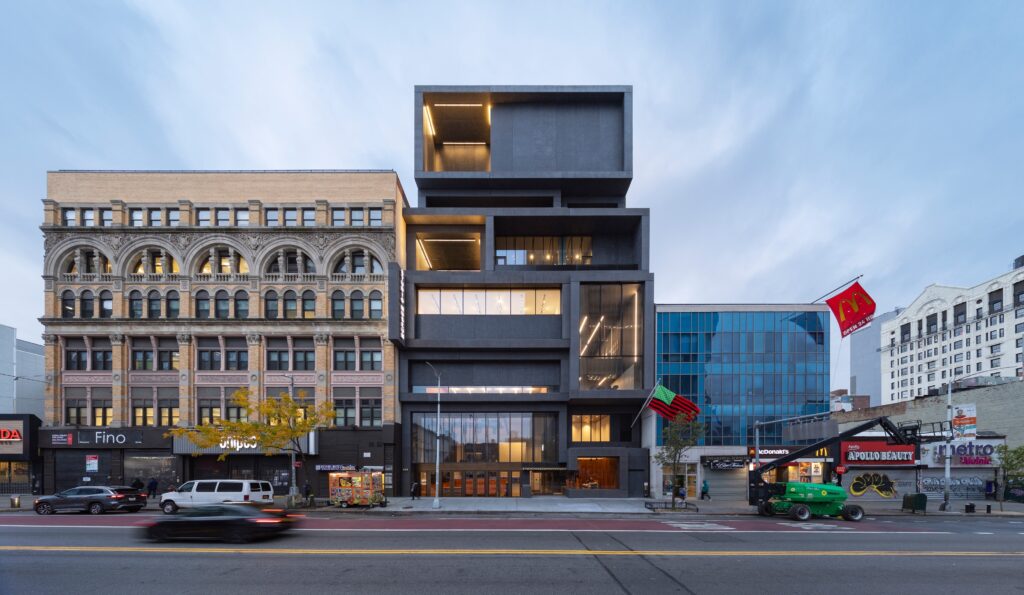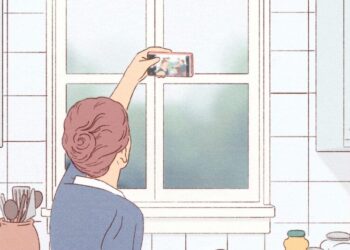History can be excruciating but it is inalienable from who we are, and it should be easier to accept both those facts. A new home for the Studio Museum in Harlem, designed by David Adjaye, expresses both ideas and the tension between them, and it makes that tension beautiful.
The Studio Museum, founded in 1968, has been the single most important institutional force in America for the promotion and understanding of work by Black artists and artists of the African diaspora. Since the museum closed in 2018 to begin construction of a new home on 125th Street in Harlem, the nation has dealt with the covid-19 pandemic, which heightened existing inequities and delayed the museum’s reopening. It also witnessed the 2020 murder of George Floyd by police in Minneapolis, the social upheaval and protests that followed and the reelection of Donald Trump on a campaign that exploited racial difference and promised to overturn all the gains of diversity, equity and inclusion programs.
But spend an hour, or ideally several hours, in the museum’s new home, and the past seven years may feel like a series of crazy detours, futile dead ends and bizarre rearguard actions to avoid the inevitable. Black art is more powerful and lasting than the tawdry forces arrayed against it.
The new, seven-story structure sits on the same lot as the museum’s earlier home, a century-old building that once housed a bank and was adapted over the years to serve Studio’s growing audience and ambition. The design by Adjaye Associates with Cooper Robertson fronts the street with a compelling geometry of dark boxes, some stepped back, others subdivided into smaller rectangular forms. It sits on a stretch of 125th Street that includes the brutalist 1973 Adam Clayton Powell Jr. State Office Building, which towers over the neighborhood and creates a dispiriting void of urban life at ground level.
The new Studio Museum responds to this context — this living history of misguided urban interventions — by being gently assertive yet neighborly, taller than the two structures on either side and in a distinctly different language, yet not wildly out of scale. The magic of the building, however, is inside, where a relatively small footprint is used with grace and intelligence to suggest something monumental and inexhaustible. Like the art on view — which includes two full floors devoted to a rotating survey of the permanent collection — the building invites exploration, drawing you in, and up, until you find yourself on the roof level, looking through a large and purposely designed opening in the facade that frames the behemoth state office building across the street.
Like the Whitney Museum of American Art, which moved to a new home a decade ago, the new Studio Museum wants to connect visitors to the neighborhood around it. An auditorium that descends from a wall of glass doors at street level is meant to suggest the front stoops of Harlem, an essential venue of social life. A barrel-vaulted gallery on the third floor is meant to recall the churches that played a key role in the social and political organization of African Americans. Towering over the rooftop garden (designed by the Harlem-based Studio Zewde), elevated water tanks on an adjacent roof become sculptural, as if the ubiquitous gargoyles of Manhattan’s domestic skyline have been domesticated and brought into the museum’s peaceable kingdom.
But the Renzo Piano-designed Whitney looked out on, and celebrated, the West Village, a neighborhood transmogrified beyond recognition by the explosion and concentration of wealth in the past 20 years, reaffirming the museum’s affiliation with the values and ethos of the billionaire class that sustains its operation. The Studio Museum looks out on and celebrates a much more human place, and its interior spaces feel decidedly more human and humane, too.
Visitors ascend through the museum via a massive central staircase, clad in dark terrazzo. It feels at first intrusive, weighty, almost oppressive, but its landings open up to the galleries, which are gracious and welcoming. The galleries have their own tensions: some windowless, interior rooms; others with views to the city. This not only serves the art well, creating an array of differently scaled spaces with control over natural and artificial light, it mimics the experience of art itself: sometimes drawing us inward, sometimes opening us up to the larger world.
The largest exhibition mounted for the reopening, “From Now: A Collection in Context,” demonstrates the museum’s prescience and influence in the evolution of a now-established canon of Black art. When the Studio Museum was founded in 1968, it wasn’t a collecting institution, instead focusing its energies on supporting artists and displaying their work. An exhibition list from its first year demonstrates the staying power of the artists, and the art, it championed: Roy DeCarava, Sam Gilliam, Mel Edwards, Walter T. Williams and Afro-Haitian art were included in its earliest exhibitions.
But the museum’s relationship with artists was mutually supporting, and it was soon being gifted work by the creators it supported. By 1977, it had established a formal collection policy and it has since gathered some 9,000 works by more than 800 artists.
Visitors are greeted by Lorraine O’Grady’s playful but subversive collection of photographs, “Art Is…(Girlfriends Times Two),” images made at an African American Day parade in 1983. Participants were photographed holding up picture frames, thus framing themselves and symbolically joining a history of portraiture from which ordinary people, and people of color especially, were long excluded.
That parade was held on Adam Clayton Powell Jr. Boulevard, which intersects 125th Street just steps away from the museum’s front entrance. And thus, we see in its exuberant representation of people a glimpse of the Adam Clayton Powell building, connecting the artwork to the building, the building to the city and the city to history. The joy in O’Grady’s photographs makes the architectural wound to the city feel almost incidental.
The main exhibition, spread over two floors, is organized thematically, with key chapters devoted to the city, the body and the fraught question of visibility and invisibility. There is no overarching idea or argument, but there are several moments of exceptional power. Barbara Chase-Riboud’s oversize, imposing 1973 “Le Manteau (The Cape) or Cleopatra’s Cape” is framed by a window onto the street. It is an intricate work, made of tiny tiles of copper woven into a regal cloak, and it looks as if it might walk out into the city and stride its streets animated by the energy of its own craftsmanship.
An exhibition of sculpture by Tom Lloyd, whose work was featured at the opening of the museum in 1968, fills the vaulted, third-floor gallery designed for large-scale work or monumental installations. His light sculptures have the brevity and concision of modern-day emojis, but were constructed with meticulous analogue pieces, Christmas lights encased in refractive glass that change color like animated hieroglyphs. These are among many works that remind visitors of the breadth of Black art over the past century, encompassing abstraction and representation, the political and the personal, and the full range of subjects and styles that animated artists who had readier access to richer, more influential galleries, museums and collectors.
I was transfixed by one work that continues to haunt me, Deborah Roberts’s 2019 mixed-media collage “Stinney,” which refers to George Stinney Jr., a 14-year-old boy wrongly accused and executed in 1944 for murder. He was so small when they put him in the electric chair that his executioners made him sit on a bible. Stinney’s conviction was overturned in 2014.
In Roberts’s collage, the boy is pushed off to one side of the image, as if he has retreated to a corner or is too small to fill the canvas. Superimposed on a photograph of Stinney’s bewildered face are masklike images of eyes and a mouth that screams with a fury the boy cannot muster. The image refers to an exceptionally painful moment in American history; but it is also powerful simply as art, restrained, anguished and ominous.
Since he undertook the commission to design the museum, Adjaye has been accused of sexual harassment and creating a toxic work environment at his firm, based in London. That put the museum in a difficult spot, intimately associated with a designer who has mostly disappeared from public life. But the building that he designed is an invaluable asset for the museum, and it should draw new generations of visitors to an institution that has been greatly celebrated, yet is often overlooked by many who flock to the Met, the Museum of Modern Art, the Guggenheim or the Whitney downtown.
If you haven’t been there yet, put it at the top of your list.
The Studio Museum in Harlem is open Wednesday through Sunday at 144 West 125th St., New York.
The post The Studio Museum in Harlem is back, and newly dazzling appeared first on Washington Post.




